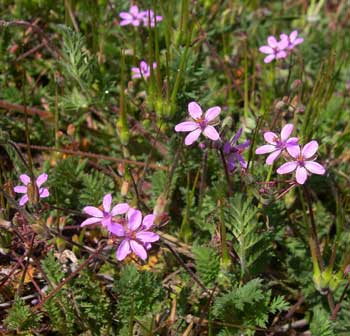Contents:
Common Names | Parts Usually Used | Plant(s) & Culture | Where Found | Medicinal Properties
Legends, Myths and Stories | Uses | Formulas or Dosages | Nutrient Content | Bibliography
Scientific Names

- Alfilaria
- Heron’s bill
- Pin clover
- Red-stem filaree
Common Names
- Alfilaria
- Heron’s bill
- Pin clover
- Red-stem filaree
Parts Usually Used
The leaves
Back to Top
Description of Plant(s) and Culture
Storksbill is an annual plant, 3 to 12 inches high; the slender, fern-like, hairy, reddish, decumbent stem bears pinnate leaves which, like those of the basal rosette, have sessile, oblong or ovate-oblong leaflets which themselves are pinnatifid into narrow, often toothed lobes. The basal leaves survive through the winter. The purple or pink, geranium-like, 5 petaled, flowers, less than 1/2 inch long, bloom from early spring to late fall. The sepals are terminated by 1 or 2 white, bristle-like hairs which give the plant its name. Seeds are smooth, elongated, and sharp, like a stork’s bill.
Another plant: The plant (Geranium maculatum) is called storksbill but has no relation to Erodium cicutarium.
Back to Top
Where Found
Native to the Mediterranean region and widely naturalized in dry and sandy soils, waste places of the eastern, southwestern, and western United States, where it is often grown for hay.
Back to Top
Medicinal Properties
Astringent, hemostatic
Back to Top
Legends, Myths and Stories
The alum root (Geranium maculatum) is also called storksbill, among other common names.
Back to Top
Uses
It has been used primarily against bloody discharges from the uterus and to treat difficult or excessive menstruations. Small doses are said to raise blood pressure, and larger doses lower it. Seed poultice is used for gouty tophus. Leaves soaked in water are put in bath water for rheumatic patients.
Back to Top
Formulas or Dosages
Storksbill will not keep long in storage. It is generally used in concentrated preparations.
Back to Top
Nutrient Content
Niacin, vitamin K
Back to Top
Bibliography
![]() Back to Eden
Back to Eden, by Jethro Kloss; Back to Eden Publishing Co., Loma Linda, CA 92354, Original copyright 1939, revised edition 1994
![]() Eastern/Central Medicinal Plants
Eastern/Central Medicinal Plants, by Steven Foster and James A. Duke., Houghton Mifflin Company, 215 Park Avenue South, New York, NY 10000
![]() The Herb Book
The Herb Book, by John Lust, Bantam Books, 666 Fifth Avenue, New York, NY. copyright 1974.
![]() Webster’s New World Dictionary
Webster’s New World Dictionary, Third College Edition, Victoria Neufeldt, Editor in Chief, New World Dictionaries: A Division of Simon & Schuster, Inc., 15 Columbus Circle, New York, NY 10023
